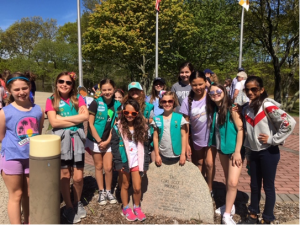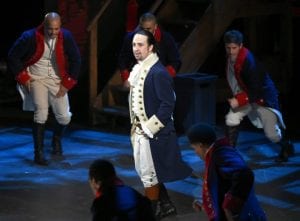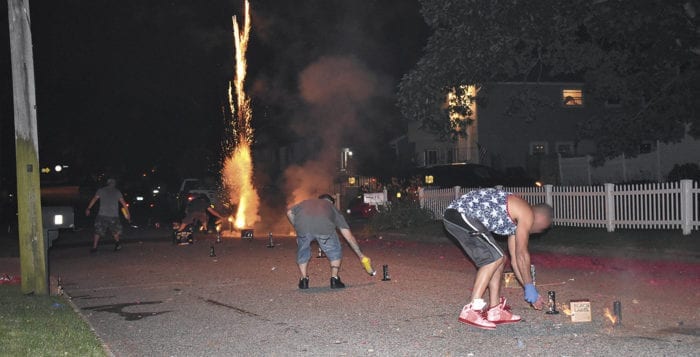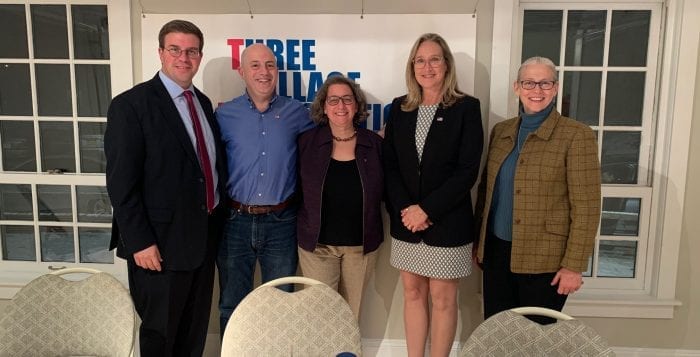A TIME FOR REFLECTION
Gretchen Mones of Stony Brook snapped this unique photo of West Meadow Creek reflecting the afternoon sky on June 14.
Send your Photo of the Week to leisure@tbrnewspapers.com
A TIME FOR REFLECTION
Gretchen Mones of Stony Brook snapped this unique photo of West Meadow Creek reflecting the afternoon sky on June 14.
Send your Photo of the Week to leisure@tbrnewspapers.com
Celebrate art and the great outdoors this summer with the Heckscher Museum’s Heckscher at Home Kids Edition: Summer Break on Saturday mornings at 10 a.m. from July 11 through August 15.
Explore a variety of different techniques and art materials as you enjoy Mother Nature. Each week will feature a new and exciting project with one of the museum’s professional educators including Watercolor Painting “En Plein Air”, Pressed Flowers Bookmark, Kindness Rocks, Sponge Painting, Leaf Rubbing and Tin Foil Marker Printmaking.
Videos premiere on YouTube on Saturdays at 10 a.m., and are available for free any time on www.Heckscher.org!
The Smithtown Library’s Long Island Room, located in the lower level of the library’s main branch at 1 North Country Road in Smithtown, invites the community to participate in an important project.
Over the course of the last few months, the coronavirus pandemic and subsequent shutdowns have had a dramatic impact on the entire world and our own community. As challenging as these times are, however, it is important to recognize and document the historical significance of this period so that future generations may learn from it.
Ways you can participate include collecting relevant items, keeping a journal reflecting on your experiences and sharing photos and/or videos of the way your life or surroundings have changed.
For more information about this project and collecting examples, please visit https://smithlib.org/documenting. If you are interested in donating materials to this collection or have any questions, please contact the Long Island Room via email at [email protected]. Please do not bring any materials to the library at this time or before contacting the Long Island Room. For further information, please call 631-360-2480.

The Three Village Historical Society had to make the difficult decision to cancel all of its in-person programs and events for the spring and summer. In light of the financial devastation caused by COVID-19, it recently launched a “Safe at Home” t-shirt campaign fundraiser in honor of Hub Edwards to help ensure that it can resume events this fall and continue to provide educational programs for years to come.
This limited run, made-in-the-USA t-shirt features the original 1950s Setauket Baseball Team logo with the words “Safe at Home,” a sentiment we can all relate to during the global pandemic. It is printed in a baseball diamond with Hub’s number on the community team, “24.” He has been riding out this quarantine, “safe at home,” and will be celebrating his 91st birthday later this year.
Hub Edwards: From Chicken Hill to the Three Villages, a man about community
The Three Village Historical Society works within the community to explore local history through education. Educational programs are developed by collecting and preserving artifacts, documents, and other materials of local significance. Ongoing research is conducted about the history of the people who have lived, from earliest habitation to modern times, in the Three Village area.
A microcosm of the diversity of America, Chicken Hill was only one mile in diameter, but home to many different people, including Indigenous Persons, Eastern and Western European immigrants, and African Americans. At its most robust, hundreds of people lived on Chicken Hill. Notable residents, such as Carlton “Hub” Edwards, called the neighborhood home. Chicken Hill and its residents continue to influence the Three Villages.
Edwards was born in Stony Brook. When he was four years old, he and his family moved to Chicken Hill. A prolific baseball player, in eighth grade, he pitched for the varsity baseball team. In eleventh grade, he pitched for both the varsity team and the local semi-pro team. In 1950, his three no-hitters won him the attention of the Brooklyn Dodgers. Shortly thereafter, he got two draft notices: one from the Brooklyn Dodgers and one from the government.
After his service in the Korean War, he returned home to Chicken Hill. He met and married Nellie Sands. They lived with Edwards’ widowed mother and extended family in an apartment complex in Chicken Hill; in 1958, they purchased a house in the area formerly known as West Setauket. They still live there today.
Edwards’ baseball talents were fostered and nurtured in Chicken Hill. His maternal uncles played ball; one of them could have gone pro if not for the “color barrier,” according to Edwards. Games were held in the fields near the former location of the rubber factory, as well as at Cardwell’s Corner, and the Setauket School, which was “the best field, because it was level,” says Edwards.
He and Nellie remain pillars of the Three Villages, socially and civically engaged in many causes. For 40 years, he worked as a custodian in the Three Village Central School District before retiring in 2000. He has been a member of the Irving Hart American Legion Post for 64 years, and in non-pandemic times, speaks every Sunday at Three Village Historical Society’s exhibit, Chicken Hill: A Community Lost to Time.
To support the Society by buying a “Safe at Home” t-shirt, visit www.tvhs.org. T-shirts sell for $25 plus shipping. Shirts are available in 6 different colors, come in sizes Small to 4X and are proudly made in America. The fundraiser runs through Friday, July 31. 100% of the proceeds will be used to help support and fund the Three Village Historical Society’s education programs.
By Daniel Dunaief
Stony Brook University recently added a wife and husband team to its Pathology Department. Felicia Allard and Eric Yee are joining SBU from the University of Arkansas.
Allard and Yee will “replace an individual who had moved to a leadership position at another institution and to meet increased caseloads in surgical pathology and cytopathology,” Ken Shroyer, the chairman of the Pathology Department, explained in an email.
Times Beacon Record News Media will profile Allard and Yee over the next two weeks.
Felicia Allard

A self-described “mountain girl” from Colorado, where she attended medical school and met her husband Eric Yee, Felicia Allard had only been to Long Island three times before accepting a job at Stony Brook.
She came once when she was interviewing for a residency and twice during the interview process.
Allard and Yee accepted the jobs in the middle of February and weren’t able to look at potential homes during the height of the lockdown caused by COVID-19.
For now, the couple have moved into temporary housing in Port Jefferson Station, as they look for longer term living options.
Allard, who will be an Associate Professor at SBU, said the move started with Pathology Department Chair Ken Shroyer, who was looking to fill two positions and reached out to Yee.
Shroyer was involved in a type of cancer work that interested her.
“The active pancreatic cancer research group was a big draw for me as I am hoping to expand my research career,” Allard explained in an email.
Allard said she was particularly interested in pancreatic cancer, in large part because of its intractability and the poor prognosis for most patients.
“It was clear to me that this is one of the areas where we had a lot of work to do in terms of being able to offer any type of meaningful treatment to patients,” she said.
Allard said she, like so many others in the medical community, entered the field because she wanted to make a difference. She searched for areas where the “greatest good could be done, and pancreatic cancer is still one of those.”
In her initial research, she studied the pancreatic neoplasm, exploring how cells went from pre-invasive to invasive to metastatic conditions. She is interested in how the tumor interacts with the patient’s immune system.
While Allard will continue to provide clinical services, she plans to collaborate with Shroyer in his lab. “I’m hoping naturally to be integrating into Dr. Shroyer’s group,” Allard said.
Shroyer welcomed Allard to the department and to his research team.
Allard is “a highly-qualified surgical pathologist with subspecialty expertise in GI tract pathology,” Shroyer wrote in an email. “She has a specific interest in pancreatic cancer, which will also complement our translational research program,” he said.
Shroyer expects that Allard will be integrated into several cancer research programs and he is “looking forward to having her join my team that is focused on the validation of prognostic and predictive biomarkers for pancreatic cancer.”
Shroyer’s lab, which includes Luisa Escobar-Hoyos, who is an Assistant Professor in the Department of Pathology, will work with Allard to advance the translational aspects of keratin 17 research, building on earlier work to understand the mechanisms through which K17 causes tumor aggression, he explained.
As for her clinical work, Allard said she analyzes biopsies and resections from the esophagus, stomach, intestines, liver, and pancreas. She has also used cytopathology to look at pap smears and to analyze salivary tumor aspirations.
The time to consider any of these slides varies broadly. Sometimes, she receives a slide and the diagnosis is unequivocal within 30 seconds. Other times, a biopsy from a six-month old patient with diarrhea, for example, can have an extensive list of differentials. In that case, the diagnosis can take considerably longer, as a baby could be sick because of an autoimmune disorder, inflammatory bowel disease or an infection.
She said she can “perseverate for hours or even days” over the subtle clues that may help with a diagnosis.
Allard likened the diagnostic process to reading a detective novel, in which the reader might figure out the perpetrator on page three, while other times, the culprit isn’t discovered until page 300.
Allard said she and her husband have a similar clinical background.
Yee is “more of a tech geek than I am,” she said. “He understands artificial intelligence, computer science and bioinformatics more than I do. He is also interested in administrative and leadership to a greater degree.”
Allard said she and Yee may have professional overlaps, but they have unique interests, backgrounds and perspectives that they bring to work that give them each different strengths.
Allard said she knew she wanted to go into medicine in her junior year of high school. When Doctors Without Borders won the Nobel Peace Prize in 1999, she recalls being impressed with that distinction.
In medical school, she said the field of pathology appealed to her because she appreciated the marriage of clinical care and basic science in the field.
She and Yee started dating just before medical school started for her. Yee was two years ahead in school. They continued their relationship from a distance while he did his residency at Beth Israel Deaconess Medical Center at Harvard Medical School. While she was a resident, Allard said Yee had the “distinct pleasure of trying to train me.”
She likes to explore the boundaries of diagnosis to understand the nuances and all the data that factor into interpretations, to tease the art from the science.
Outside of her work, Allard enjoys reading and calls her Kindle one of her favorite possessions. She hopes to learn how to sail while a resident of Long Island.
Allard is excited to start working at Stony Brook. Shroyer was “very persistent and once he got us up to New York to interview, he was persuasive with respect to the type of career growth we could both potentially have,” she said.
Generous Long Islanders have been finding ways to lend a helping hand to staff at Gurwin Jewish Nursing & Rehabilitation Center in Commack who have been on the frontlines of the COVID-19 battle, as well as Gurwin residents who are missing their loved ones due to the “No Visitation” mandate issued by the New York State Department of Health in March.
16-year-old Melville resident Emily Rind created 370 care packages filled with puzzles, word search books, activities and sundry items to help keep Gurwin’s residents entertained and engaged, as part of her “Put a Smile on a Senior Campaign.”
Rind, who was unable to visit her own grandmother due to New York State’s COVID-19 Stay-At-Home Order, said she could only imagine how seniors at Gurwin must feel not being able to see their loved ones. “I reached out to Gurwin to see which items were most needed, and then posted flyers around town to collect supplies,” said Emily. Affixed to the care packages was a note which read, “I know it must be hard not seeing your family and loved ones, so I hope this will brighten your day and put a SMILE on your face.”

In another show of support for Gurwin healthcare workers, fifth graders in Melville Girl Scout Troop 3650 dedicated their Bronze Award project to providing handmade personal protective equipment (PPE) for the staff. Troop members created face shields using 3D printers, as well as masks and ear guards, items that were in scarce supply during the onset of the pandemic.
“In these challenging times when our staff are working their hardest to protect the well-being of those in their care, and when are residents are missing their families, the thoughtfulness of people in our local community like Emily and the Scouts in Troop 3650 really make a difference in helping to keep morale and spirits high,” said Nicole Hopper, Director of Therapeutic Recreation at Gurwin.
Reviewed By Jeffrey Sanzel
No single theatrical event of the past ten years has had the presence of the musical Hamilton. The powerhouse blockbuster crossed into everyday culture unlike any previous work in the American theater. Eleven Tony-Awards and the Pulitzer Prize is only the beginning of the list of accolades and honors Hamilton has received. Ardent fans in New York and across the country guaranteed years if not decades of sold-out performances.
In full disclosure, I saw the Broadway production as well as the national tour. In 1923, literary critic Samuel Taylor Coleridge said of Edmund Kean: “To see him act, is like reading Shakespeare by flashes of lightning.” Until I sat in a theater and watched Hamilton, I had not truly appreciated this statement. (Theatre Three alum/Long Island native Ryan Alvarado was the standby for Hamilton, Burr, and King George in the tour. I had the great joy of seeing his extraordinary performance in the titular role in San Francisco.)
 Hamilton: An American Musical (its full title) is the sole creation of the unparalleled Lin-Manuel Miranda who had already risen to prominence with his In the Heights. Miranda used the Ron Chernow biography Hamilton (2004) as his source, but this is no traditional musical biopic. With his unique book, music, and lyrics, he has fashioned a celebration unlike any other, and in doing so, has redefined what theater can be.
Hamilton: An American Musical (its full title) is the sole creation of the unparalleled Lin-Manuel Miranda who had already risen to prominence with his In the Heights. Miranda used the Ron Chernow biography Hamilton (2004) as his source, but this is no traditional musical biopic. With his unique book, music, and lyrics, he has fashioned a celebration unlike any other, and in doing so, has redefined what theater can be.
The score is flawless alchemy, drawing from hip hop, R&B, pop, and soul as well as traditional musical theater. Each song is a crafted gem of tune and words, perfectly fitting the moment and the character. The book alternates between the historical and the personal, shifting seamlessly from one to the other. Director Thomas Kail and choreographer Andy Blankenbuehler clearly understood Miranda’s intentions as their staging is both breathtaking and clear, synthesizing every moment, every beat.
The casting of people of color is not about color-blind or color-conscious casting. It is not a theatricalization or a nod towards political correctness. It can be taken as a bold statement about the founding of this country, including its references to immigration. It is a fusion of history and time, reflecting both its historical roots and the era in which it first appeared. However, it is a different world from when Hamilton opened in 2015, and the musical’s resonance is quite different in 2020.
The Hamilton that made its debut July 3 on Disney Plus is edited from three live performances in 2016 plus several scenes that were filmed in an empty theater to provide the opportunity for close-ups. Christmas has come early because this is a gift.
 Over the years, there have been various attempts to bring the experience of live theater to television with varying success. The American Playhouse presentation of Into the Woods (1991) was one of the stronger examples, featuring the show’s original cast. The Public Theatre’s presentation of The Apple Plays, composed of four plays by Richard Greenburg, worked extremely well. It’s interesting to note that a fifth Zoom/COVID play presented in April — without an audience — was the best of all of them.
Over the years, there have been various attempts to bring the experience of live theater to television with varying success. The American Playhouse presentation of Into the Woods (1991) was one of the stronger examples, featuring the show’s original cast. The Public Theatre’s presentation of The Apple Plays, composed of four plays by Richard Greenburg, worked extremely well. It’s interesting to note that a fifth Zoom/COVID play presented in April — without an audience — was the best of all of them.
The recent line of live productions made for television — a clumsy Sound of Music, an overly rewritten The Wiz, a painfully wrong-headed Peter Pan — are examples of how not to do it. Oddly, Grease managed to capture some of the excitement and energy of a live performance — highlighted by actors rushing from soundstage to soundstage in golf carts. While it’s not exactly theater, the “live” element was maintained.
This is a long way of saying that there is always a danger of trying to capture those “flashes of lighting.”
However, stage director Kail has wisely chosen to offer as close to a faithful representation of seeing it in the theater as possible. The majority of the taping is in wide-shots that allow for the scope of the production, but there is still a liberal use of close-ups as well as shots from backstage towards the audience, from the wings, etc. Kail emphasizes the big picture but knows when to bring us in to the individuals. The compensation for not being “in the room where it happens” is that we are given an opportunity to see myriad details that we certainly would have missed in the theater.
 One of the treasures of this recorded Hamilton is that it preserves the original company. And this cast is exceptional: a group of young (only two casts members were even in their forties) and astoundingly talented singer/dancer/actors execute a story with not only precision and commitment but unparalleled joy.
One of the treasures of this recorded Hamilton is that it preserves the original company. And this cast is exceptional: a group of young (only two casts members were even in their forties) and astoundingly talented singer/dancer/actors execute a story with not only precision and commitment but unparalleled joy.
As Hamilton, Miranda mines both the humor and pathos. The pain he shows in “It’s Quiet Up Town” is only matched by Phillip Soo’s as Eliza Schuler Hamilton singing “Burn.” Daveed Diggs plays the Marquis de Lafayette with great flair but it his outrageous Thomas Jefferson and “What’d I Miss?” that brings down the house.
Leslie Odom Jr. balances the fence-sitting reserve of Aaron Burr with his fierce, underlying desire for power and position; Odom brings reality to Burr’s complicated psyche and his “The Room Where It Happens” is a breath-taking showstopper.
Jonathan Groff literally foams at the mouth as King George, who is simultaneously hilarious and dangerous. Renée Elise Goldsberry’s exposed honesty as Angelica Schuyler shows the entire range of human emotions in “Satisfied,” the counterpoint to her sister’s “Helpless.”
Christopher Jackson brings dignity and humility to George Washington, especially in his farewell “One Last Time.” And while several principals play dual roles, none is better than Okieriete Onaodowan as the brash Hercules Mulligan and the almost blushing James Madison; it truly is like watching two entirely different performers.
Thousands of words have been written on Hamilton but none can capture the magic of this landmark work of art. It should — no, must — be seen. “Flashes of lightning?” Hamilton is a full-on electrical storm.
Rated PG-13, Hamilton: An American Musical is now available on Disney Plus.

For the past month or so, the sounds of fireworks have rang throughout the night in many parts of Long Island. Despite fireworks being banned in New York State for decades, Suffolk and Nassau officials have acknowledged seeing an increase in the number of complaints to police departments about illegal fireworks.
The increase could be attributed to the lack of official Fourth of July firework display due to the coronavirus pandemic, or simply boredom.
Suffolk County Executive Steve Bellone held a media briefing with Suffolk Police Chief Stuart Cameron prior to July 4 to warn residents about the dangers of using illegal fireworks. During the event, they showcased the dangers and destruction of fireworks by igniting a collection of pyrotechnics in a camper.
This past holiday weekend there have been several firework injury incidents in Suffolk County. A man in Port Jefferson Station was injured when he attempted to light a firework that explored and injured one of his eyes. Additionally, a 29-year old man in Central Islip was severely wounded in the hand from an exploding firework. The man was at home on Tamarack Street when the injury occurred around 9:10 p.m. He was airlifted to Stony Brook University Hospital.
Facebook community groups have also taken notice of the increase in illegal fireworks, People on community Facebook pages have made a number of posts throughout the past couple of months with complaints over fireworks. People not only recognized the negative effect it had on animals, but others mentioned a child with special needs constantly being woken by the loud bangs outside.
According to the U.S. Consumer Product Safety Commission, about 230 people a year are treated in emergency rooms because of injuries caused by fireworks. In 2017, sparklers caused 1,200 injuries.
“Every year, we do these reminders and talk about the dangers of fireworks,” County Executive Steve Bellone (D) said during a call with media after the holiday weekend.
Suffolk County Police Department Chief Stuart Cameron said the county did have a higher incidence of fireworks-related calls, due to the limitations on large crowds at the usual fireworks shows.

By Kyle Barr and David Luces
After nearly two weeks of anticipation since ballots were first cast, Stony Brook University scientist Nancy Goroff has come out on top of a slate of Democratic contenders running for the 1st Congressional District. She will run against U.S. Rep. Lee Zeldin (R-NY-1) in November.
With votes still to be certified, officials at the Suffolk County Board of Elections confirmed Goroff won by a margin of 630 with 17,905 votes, after all absentee ballots were finished counting Thursday, July 9. Last year’s Democratic contender Perry Gershon came out with 17,275 while Bridget Fleming, a Suffolk County legislator from Sag Harbor, finished with 13,696. Gregory Fisher had 773 total votes.
Goroff congratulated both Gershon and Fleming for the race, and extolled this year’s turnout of being nearly double that of 2018.
In her message to voters, Goroff also said that Zeldin had put “hyperpartisan spin over science and over the needs of our community.”
Gershon, on Twitter, congratulated Goroff on her winning the primary, adding, “I am confident that Nancy will offer real solutions.”
“It was an honor working to be your representative in Congress and I am very sorry I will not be our party’s torchbearer in November,” Gershon wrote on his campaign Facebook page. “I will be
honored to do whatever I can to assure Nancy’s victory.”
Goroff, 52, has been chair of SBU’s chemistry department until taking a leave of absence to campaign. She is also President of Gallery North’s board of trustees and lives in Stony Brook.
This post will be updated when comments from Zeldin and Fleming become available.
When The New York Times recently published an editorial titled “Don’t Cancel That Newspaper Subscription,” it caught our attention. Not just because of the subject matter — anything about the general decline of local newspapers is, of course, something we’re very concerned about — but because of the struggles each reporter and editor faces while trying to do their jobs.
The beginning of the editorial tells the story of John Seigenthaler, initially a young reporter with The Tennessean who saved the life of a man he was interviewing back in the 1950s. Seigenthaler went on to become editor and then publisher for the local paper and was at the forefront of civil rights coverage in the heart of the segregated South. However, the piece is not a love letter to the local papers of the 20th century; it’s a cry for help for the publications of today.
The editorial touches on how newspapers and their newsrooms have become smaller over time, even before the coronavirus pandemic diminished the amount of advertising, the main source of revenue papers rely on. Over the years, local publications have been suffering as more and more readers take to the internet to get their daily or weekly dose of news. It also doesn’t help that the false moniker of “fake news” is thrown around by too many without a care for the consequences such an impetuous statement can create.
According to the editorial, newsrooms across the country lost half their journalists between 2008-19. Citing a recent Business Insider article, the writer Margaret Renkl, said “a staggering” 7,800 journalists lost their jobs in 2019.
The writer goes on to tell the story of how The Tennessean recently ran an ad that many found appalling and racist, but she urged people not to cancel their subscriptions. She not only cited how the publisher quickly tried to rectify the situation by pulling it from future editions and firing the sales manager that approved it, but she pointed out many other things, too. Despite the extreme lack of judgment in placing the ad, even with a shortage of journalists due to cutbacks over the years, the paper still covers and publishes a variety of topics that show it is still doing everything in its power to maintain a balanced and reputable publication.
We get this. There have been times when some may not have been pleased with an article, letter or editorial in our newspapers. That is perfectly fine, and we invite reasoned criticism from all in our letters to the editor. But as Renkl wrote in her editorial, “As the ‘first rough draft of history’ journalism will always be prone to mistakes.” We, perhaps beyond any other industry, not only invite justified review of our papers, but we also actively try to improve, working many, many hours to try to get the story of local happenings. We cannot be everywhere and cover everything, but we do our best.
Canceling your subscription to a newspaper only hastens the death of journalism. We’ve written it before on this page, and we’ll put it out there again: If newspapers and journalists didn’t exist, who would tell you what leaders are up to? Who would be there to challenge their responses when something doesn’t sound quite right? And this is even more important with our local leaders, especially as more news networks focus on the national side of our society.
Without local papers, where would readers go to find out what fun activities are going on right in their own town? Who would celebrate the academic and athletic achievements of our local students?
Unfortunately, the days of local newsrooms brimming over with editors and reporters, who could run out and cover every incident in town, may be over, but pulling out a newspaper from the mailbox or picking one up on the newsstand doesn’t need to end.
Let’s work together to keep local journalism alive. With each subscription, just like with each ad, we are empowered to continue and enabled to cover more of our communities’ activities for the benefit of all.
